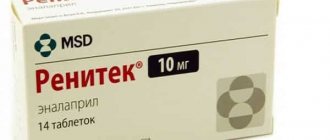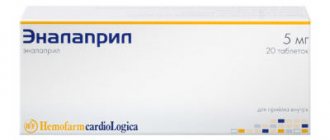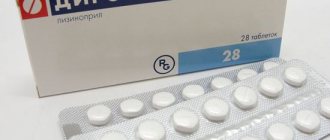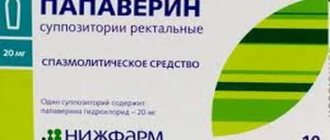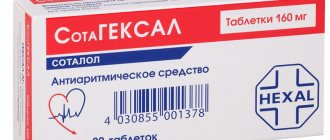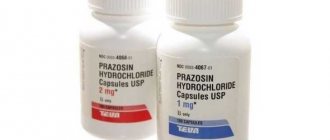Indications for use of Asparkam
The use of Asparkam is justified in cases of potassium and magnesium deficiency, in complex therapy for chronic circulatory failure.
According to the instructions, Asparkam is also prescribed for ischemia and various shock conditions. Asparkam is used for heart rhythm disturbances caused by a lack of potassium and magnesium. According to the instructions, Asparkam is indicated for such heart diseases as: ventricular extrasystole, paroxysms of atrial fibrillation. The drug is also used in case of intolerance or toxic effects of digitalis preparations on the body.
Diacarb and Asparkam in combination are used for increased intracranial pressure (including in children over four months of age), for edema syndrome, epilepsy, glaucoma, gout, Meniere's disease, as well as for potassium and magnesium deficiency. Diacarb and Asparkam are prescribed only together to enhance the effect of each drug.
Drug review
Release form and main components
It will be easier to figure out whether Asparkam increases or decreases blood pressure if you analyze the composition of the product and the principle of its action.
The drug is available in the following dosage forms:
- tablets of 175 mg of active substance - 20 or 50 pieces per package;
- injection solution, 40 mg/ml or 45 mg/ml – ampoules (5, 10 and 20 ml);
- infusion solution 7.9 or 11.5 g/l – bottles (200 or 400 ml).
The main active substances of Asparkam are:
- potassium aspartate;
- magnesium aspartate.
One of the most popular blood pressure medications is Asparkam.
The list of excipients includes:
- starch (potato or corn);
- magnesium stearate;
- talc;
- water, etc.
Pharmacological action of "Asparkam"
To reasonably answer the question whether “Asparkam” reduces blood pressure or not, let’s look at the pharmacological action of its main components:
- the drug acts as a source of potassium and magnesium ions (the maximum concentration of ions is recorded 1–2 hours after administration);
- under the influence of Asparkam, the excitability of the heart muscle decreases (due to a decrease in conductivity), which provides an antiarrhythmic effect;
- taking the drug helps restore electrolytic balance in the body;
- as a result, high blood pressure (BP) decreases, and at the same time blood circulation in the coronary vessels is normalized.
An additional effect of taking Asparkam is to stimulate the synthesis of a number of aminocarboxylic acids in the body.
The drug has high bioavailability and is excreted by the kidneys.
It is usually prescribed in combination with other drugs, since cardiovascular diseases need to be treated from different angles
Indications for use
“Asparkam” is prescribed quite often for blood pressure and other pathologies. Main indications for its use:
- heart rhythm disturbances (arrhythmia) and associated pathologies;
- deficiency of potassium ions;
- deficiency of magnesium ions;
- elevated blood pressure;
- increased intraocular/intracranial pressure;
- tendency to epileptic seizures;
- pathologies of the inner ear;
- some joint diseases.
Asparkam is used for high blood pressure almost always as part of complex therapy. The dosage and duration of the course in each specific case should be determined by the attending physician.
Contraindications
Unlike high blood pressure, Asparkam is not recommended for use with low blood pressure - the result can be an uncontrolled significant decrease in blood pressure with many negative consequences.
It is not recommended to take Asparkam for low blood pressure; it is better to pay attention to other drugs
In addition, contraindications include:
- conduction disorders of the heart muscle;
- hyperkalemia/hypermagnesemia;
- kidney pathologies (failure, diseases of the adrenal cortex);
- severe pathologies of neuromuscular nature.
In case of intolerance or increased individual sensitivity, Asparkam is also not prescribed for high blood pressure. In this case, its analogues or alternative drugs with a similar therapeutic effect are used.
Analogues of the drug
Asparkam is a fairly old drug that is produced today by many pharmaceutical companies. You can buy it under the following names:
Instructions for use of Asparkam
Asparkam tablets are taken orally, after meals, 2 tablets three times a day. For prevention and as a maintenance dose, Asparkam tablets are taken 1 piece three times a day for a month. If necessary, the course can be repeated. According to the instructions, Asparkam in solution is administered intravenously by drip or intravenous stream at a slow pace. For intravenous infusion of the drug, 20 ml of Asparkam is diluted in 100-200 ml of sodium chloride 0.9% or glucose solution 0.5%. The dose for adults is 10-20 ml once or twice a day, the rate of administration is 25 drops per minute. For intravenous injection, 10 ml of Asparkam is diluted in 20 ml of 0.9% sodium chloride solution. Asparkam is administered into a vein no faster than 5 ml per minute.
The course of treatment with the drug varies widely and is prescribed by a doctor. This is confirmed by reviews of Asparkam. On average, the use of Asparkam is advisable for 8-10 days.
Asparkam: similar drugs in tablets in Russia
Medications that regulate metabolic processes in the human body are classified as a separate group of substances used in the treatment of various pathologies. Asparkam is no exception: analogues can be bought at any pharmacy. In order to ensure their effectiveness, it is necessary to study the pharmacological action of these drugs, indications and contraindications for use, main side effects, as well as interactions with other substances. What analogues does Asparkam have?
The concept of the drug and its pharmacological characteristics
Asparkam is a medicinal drug that is used to regulate all kinds of metabolic processes in the human body. The action of the product is based on several important nuances.
The first is to maintain homeostasis of the intracellular ionic composition. During these processes, electrolyte indicators play one of the main roles. Due to the microelements contained in Asparkam, it is possible to control their concentration and also improve metabolism within cells.
Due to the fact that the main structure that reacts acutely to changes in electrolyte levels inside cells and blood vessels is the heart, the drug can have a protective effect on its cells.
It manifests itself:
- disturbances in excitation and conduction of impulses through cellular structures;
- providing an antiarrhythmic effect on the organ.
This product acts as a source of K+ and Mg2+, takes part in the stabilization of metabolic mechanisms, activates recovery processes while stabilizing the balance of electrolyte components. Asparkam also has a beneficial effect on the body of a patient with arrhythmia.
K+ ions are important for conducting impulses along nerve pathways, muscle contraction and maintaining stable activity of cardiac muscle fibers. If the exchange of these microelements is disrupted, disorders of the excitability of nerves and muscles can develop. The use of Asparkam helps to maintain sufficient K in cells.
Mg2+ ions act as a coenzyme for many enzymatic processes. It is an indispensable component in processes that control energy reactions in the human body.
The trace element takes part in regulating electrolyte balance, as well as the permeability of cell membranes and the conductivity of nerve fibers.
In addition, Mg2+ plays an important role:
- in DNA and RNA structures;
- when activating the mechanisms of the hereditary apparatus;
- during cell division or growth;
- to limit and prevent the release of excessive amounts of catecholamines during stress.
- aspartate plays the role of an excipient. It promotes the entry of K+ and Mg2+ into the cell, and also activates the processes of intercellular phosphate synthesis.
In addition, aspartate, which is included in Asparkam, activates metabolism, which increases the amount of amino acids, as well as sugars and lipids, which play an important role in regulating metabolic mechanisms. This effect enhances energy processes in tissues that lack oxygen and other necessary substances.
One of the best analogues of Asparkam is Panangin. It contains an identical composition, which allows one to obtain similar pharmacodynamic effects.
Features of the pharmacokinetics of the drug
Asparkam analogues are able to enter the systemic circulation over a short period of time. The drug is eliminated through the kidneys. With a single dose of the drug, its maximum concentration in the blood is observed after 1-2 hours.
From the bloodstream, Asparkam or Panangin enters the cell, after which it begins to take part in intracellular metabolic processes. Take the medications after meals, 3 times a day, 2 tablets. The maintenance or prophylactic dose of the drug is one tablet three times a day for one month.
To inject the drug, a special solution is used, which is diluted in 10 ml of 0.9% NaCl. Intravenous administration of the drug is carried out 1-2 times a day for several weeks or months.
Asparkami, its substitute Panangin, can enhance the dromotromic and bathmotropic effect of antiarrhythmic drugs. They are also able to eliminate low levels of potassium in the blood, which is caused by taking glucocorticoids or diuretics.
In addition, the drug has the following interactions:
- while taking beta-blockers, cyclosporine, potassium-sparing diuretics, heparin, ACE inhibitors, and non-steroidal anti-inflammatory drugs, hyperkalemia may develop, so it needs to be replaced;
- with the simultaneous use of atracuroni, decamethonium, suxamethonium or succinyl chloride with the drug, neuromuscular blockade is observed;
- the use of enveloping or astringent medicinal substances together with Asparkam can lead to a decrease in the performance of the gastrointestinal system;
- for polarizing impurities in combination with small amounts of insulin and dextrose, Panangin is able to normalize the rhythm that was disturbed as a result of myocardial infarction, as well as after overdoses of glycosides.
You should not take Asparkam, as well as its analogues, on your own at home. This leads to the development of complications or drug incompatibility. Therefore, it is better to trust an experienced doctor who will eliminate the possibility of their occurrence.
Indications and prohibitions for the use of the product and its analogues
Asparkam and its effective analogues in tablets are used to eliminate pathological conditions that directly relate to disturbances in the functioning of the heart and vascular system.
Among the situations in which doctors recommend using this remedy are:
- post-infarction changes;
- drop in fiber conductivity;
- hypokalemia and hypomagnesemia, which developed against the background of dysfunction of the gastrointestinal system or as a result of taking glucocorticoids;
- the presence of intoxication processes in the body.
Asparkam achieves its greatest effectiveness at the time of complex use. This fact is especially noted when the substance is used simultaneously with cardiac glycosides, during which they can act very effectively.
The injection form is actively used in the treatment of chronic heart failure, which was formed as a result of a previous myocardial infarction or arrhythmia. The drug is also effective in reducing the conductivity of muscle fibers.
Despite this, Asparkam, together with its substitute Panangin, have a number of contraindications in which their use may be ineffective or even harm the patient’s health.
Among them it is worth highlighting:
- allergic reactions to the components of the product;
- chronic pathologies in the acute stage;
- diseases characterized by impaired amino acid metabolism;
- high levels of magnesium and potassium in the bloodstream;
- blockade of heart rate drivers;
- renal pathologies;
- low blood pressure;
- hemolysis of red blood cells;
- insufficient amount of water in the patient’s body;
- acidosis due to metabolic disorders;
- the first months of pregnancy;
- lactation period.
At the same time, the funds cannot be used if a person has cardiogenic shock, in which the systolic pressure bar can fall below 80 mm Hg. Art. During this condition, taking Asparkam can harm the patient's health.
An effective analogue of Asparkam in Russia is Panangin. It is widely used in many medical institutions in the country due to identical components, as well as indications for use.
Other alternative remedies include:
- Mexarithm;
- Aspangin;
- Inosine;
- Riboxin;
- Pamaton;
- Propanorm.
This list is much wider. You can buy pills of these drugs in almost any pharmacy at an affordable price. A cheap analogue of Asparkam is Riboxin. The doctor must prescribe the dosage of the substance before use. There are instructions in the box along with the tablets, and you can read reviews about the product on forums or ask your friends.
Pamaton is one of the few imported drugs imported across the border, since its composition and effect are very similar to Asparkam. The drug lasts significantly longer than its prototype, so it is often used in the treatment of severe heart pathologies.
Only a specialized doctor can tell you what to replace Asparkam in the presence of absolute contraindications for use. He will tell you which drug is bad in a particular case, and the use of which replacement will have a good effect on the patient’s health.
Taking the drug or its analogues is allowed only after consultation with an experienced specialist. He can identify the presence of contraindications in which the use of the drug is dangerous for the patient, and prescribe its analogues.
Features of use of the product, side effects
When taking tablets orally, experts recommend taking 2 tablets 3 times a day. For the prevention of diseases or in cases where the drug is taken by a child, one tablet is used three times a day.
The duration of the course of therapy is determined by an experienced doctor. This is carried out based on the severity of the signs of the underlying disease, examination data, as well as the individual characteristics of the patient’s body.
Injections are prescribed exclusively as intravenous agents. One ampoule of the product is dissolved in 100 ml of a 5% glucose solution, after which the contents are slowly introduced into the desired vessel. You can re-administer 5-7 hours after the previous one.
In certain situations, the drug may cause adverse reactions.
For the oral type of administration of Asparkam, together with analogues, the most common among them are:
- pain in the epigastric region;
- nausea, vomiting;
- burning sensation behind the sternum;
- the appearance of ulcerative changes on the mucous membranes of organs;
- arrhythmias;
- a sharp decrease in conductivity;
- development of atrioventricular block.
When the structures of the nervous system are damaged, experts note the appearance of seizures and paresthesia. In some situations, a tingling sensation appears, which can be observed in different parts of the body.
Due to the high level of magnesium ions, as well as as a result of their contact with the fibers of the central nervous system, the functioning of the respiratory center may be disrupted. In addition, some patients experience fever after taking Asparkam. During the use of analogues, similar symptoms are noted, as well as an identical frequency of clinical manifestations of side effects on the administration of drugs.
Among the special instructions for the use of Asparkam and similar drugs, it is worth noting their use in children. Scientists have not noted any dangerous side effects when taking them in the treatment of heart disease. For this reason, they are actively used in all cardiology institutions.
When using this group of drugs, you should expect side effects that, at first glance, may not be related to their use.
These include:
- sensation of iron taste in the mouth;
- blockage of the veins of the lower extremities;
- phlebitis;
- itching of the skin;
- bradycardia;
- decreased severity of reflexes;
- headaches and dizziness;
- increased sweat secretion;
- asthenia;
- hypermagnesemia, hyperkalemia.
For long-term use of the drug, it is necessary to carefully monitor the electrolyte balance in the bloodstream, as well as the functional state of the heart and vital vessels.
In such cases, therapy with Asparkam and its analogues will be comfortable and safe for the patient’s health.
sustava.net
Side effects of Asparkam
If the recommended doses of Asparkam are not observed, side effects may develop, which is confirmed by reviews of Asparkam:
- ulcers on the gastric mucosa;
- vomit;
- diarrhea;
- flatulence;
- dry mouth;
- stomach and intestinal bleeding;
- bradycardia (decreased heart rate);
- decreased blood pressure;
- phlebitis and vein thrombosis;
- skin itching:
- increased sweating;
- dyspnea (breathing difficulty);
- muscle weakness;
- dizziness.
In case of an overdose of the drug, hyperkalemia may develop, which is characterized by muscle weakness, arrhythmia, paresthesia of the limbs, and cardiac arrest.
Interaction
In large doses, the drug reduces the effect of psychostimulants. Because it affects the pulse, it may indirectly increase the negative effects of beta blockers.
Caffeine is a known purine stimulant.
Advice! It is not recommended to use medications without a doctor's permission. Before using any product, you must consult a doctor. Some substances are contraindicated in certain diseases. The decision to prescribe medications must be made by the doctor.
Contraindications to the use of Asparkam
According to the description, Asparkam is contraindicated for:
- renal failure in acute and chronic form;
- hyperkalemia (excess potassium in the body);
- hypermagnesemia (excess magnesium in the body);
- severe form of myasthenia.
Asparkam is contraindicated in the first trimester of pregnancy. In the second and third trimester, the drug is used only as prescribed by a doctor. During pregnancy, Asparkam is usually used in tablet form.
Pharmacodynamics and pharmacokinetics
Potassium is one of the most important minerals in the human body. The ratio between potassium and sodium should be 2:1. Potassium maintains water balance in cells, regulates kidney function and promotes the proper functioning of muscles and nerves, and regulates cardiac activity.
The trace element affects protein synthesis and energy production from carbohydrates, thereby increasing the performance of athletes. Without potassium, glucose is not converted into needed energy or glycogen, which is stored in muscle fibers. Potassium eliminates fatigue and prevents allergies. The total amount of this element in the adult human body is about 100 g.
Potassium
Potassium is found in tomatoes and leafy vegetables, fresh and dried fruits (especially bananas, apricots, plums, raisins and citrus fruits), nuts, potatoes, whole wheat flour, cereals, milk, chicken, liver and mushrooms.
Daily potassium intake should be within 2-4 g. During sports competitions, it is necessary to increase the amount of the microelement.
Potassium deficiency occurs due to severe diarrhea and vomiting, laxatives and diuretics. When this electrolyte is deficient, the function of the nerves leading to the muscles deteriorates, resulting in weakness and a feeling of heavy muscles. Heart rhythm disturbances, loss of appetite, constipation, insomnia, swelling, nervousness and fatigue are symptoms of hypokalemia. With long-term deficiency, an increase in blood pressure is observed.
Hypertension
Elevated levels of potassium in the blood cause muscle weakness, irregular heartbeat, or collapse of the circulatory system, which can lead to cardiac arrest.
The human body contains 20-30 g of magnesium. About 40% is stored in muscle cells and heart muscle, and the remaining 60% is stored in bones. Magnesium and calcium are involved in the construction of teeth and tendons, and the transmission of information from nerves to muscles. Together they help maintain the natural tension of the cell wall (magnesium is on the inside and calcium is on the outside).
The connection between these minerals must be balanced. Calcium itself can cause magnesium deficiency, while excessive magnesium prevents calcium absorption.
Magnesium promotes the formation and activation of more than 300 enzymes. It acts preventively against thrombosis and heart attack (prevents blood clotting), flatulence and the formation of kidney stones, and plays an important role in the process of converting sugar into energy. It calms the nervous system, regulates heart rhythm and is useful in treating prostate problems. High protein intakes, especially in athletes such as weightlifters and bodybuilders, require increased magnesium intake.
Good suppliers of this microelement: whole grains, wheat germ, nuts, soybeans, cocoa, natural rice, fish, poultry, lamb, cheeses. Don't forget about vegetables and fruits. The richest foods in magnesium are corn, figs, lemons, and apples.
The daily requirement for magnesium is about 300-400 mg. Pregnant and lactating women are recommended to take a high daily dose - up to 450 mg. Unfortunately, consumption of refined foods (white flour, rice) causes a relative deficiency of magnesium in the body.
Loss of this mineral results in significant sweating or fever. It is not recommended to take magnesium after meals as it reduces stomach acid.
Hypomagnesemia occurs with excessive sweating, diseases of the digestive tract associated with chronic alcoholism, and one-sided nutrition. Magnesium is excreted through the kidneys and intestines. Magnesium deficiency manifests itself in nervous and heart disorders, anxiety, dizziness, depression, palpitations, and weight loss. This negatively affects metabolism, leading to increased fatigue, weakness and painful muscle cramps.
Dizziness
Important! Healthy people should not be afraid of excess magnesium. This condition can be dangerous for people with hyperfunction of the kidneys or thyroid gland. An overdose of magnesium in this case can cause muscle weakness, drowsiness, lethargy, and impaired coordination of movements.
Adequate magnesium intake helps prevent diabetes. This is especially true for people who are predisposed to this disease. A new study conducted by scientists at Tufts University in Medford, Massachusetts, concluded that daily intake of this substance lowers blood glucose levels.
Magnesium is essential for more than 300 different chemical reactions in the body, helping to digest proteins, carbohydrates and fats. The aforementioned scientific team, led by Adela Hruby, found that healthy people with increased magnesium intake showed a 37% reduction in blood sugar concentrations.
Patients who already had early symptoms of diabetes were able to significantly improve their status with adequate magnesium intake. Compared to the control group, the disease was 32% less common among the subjects.
Consuming whole grains, fish, vegetables, dark chocolate, nuts and seeds reduces the risk of developing diabetes. The study was published in the journal Diabetes Management and is part of the Framingham Heart Study, which has been studying the leading causes of cardiovascular disease since 1948.
The project initially involved more than 5,000 Framingham residents aged 30-62 years who completed medical examinations and completed lifestyle questionnaires. Since 1977, other people have been included in the project - adults and children.
In 1994, 2002 and 2003, the next generation was brought in to collect large amounts of data. Heart disease has been shown to be associated with high blood pressure, cholesterol, smoking, obesity, diabetes and physical inactivity.
The new study used data from the Framingham Heart Study, accumulated over the past 7 years and obtained from more than 2,500 volunteers with an average age of 54 years. When assessing the benefits of magnesium, similar results were obtained, although the source was fruit. It has been shown that magnesium may be a key preventative in people at increased risk of developing diabetes.
Only half of Russians meet their daily magnesium needs from food. For adult men it is 400-420 mg, and for women – 310-320 mg.
Today's science is once again revealing the hidden benefits of this important mineral. Magnesium is needed to create and store energy in the body
Magnesium and potassium not only support the proper functioning of organs, but also have therapeutic value. They are used to treat headaches, chronic pain, asthma and sleep problems. Magnesium deficiency has been linked to severe depression, as this mineral is needed for the synthesis of serotonin.
Composition and release form
The pharmaceutical product “Asparkam” is sold in the form of tablets that have a white color and a specific aroma, as well as in the consistency of a solution intended for intravenous and intramuscular injections. The tablets are packaged in blister cells of 50 pieces, each package contains 1 blister. The medicinal solution is sold in ampoules of 5 or 10 ml.
Enter your pressure
Move the sliders
120
on
80
The described medication contains the following components:
- potato or corn starch;
- food additive E572;
- talc;
- Mg and K aspartate;
- sorbitol;
- water for injections.
